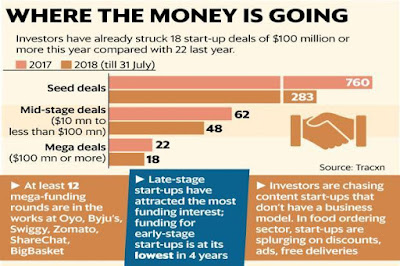Starting with the Flipkart-Walmart deal, 2018 is turning out to be the best ever for startups in attracting capital since the funding boom on 2014-15
Mihir Dalal & Anirban Sen from LiveMint.com August 6, 2018
Caption:
At least 12 mega funding
rounds are in the works at Oyo, Byju’s, Swiggy, Zomato, ShareChat
and BigBasket. Graphic: Mint
Bengaluru: Startups
have been raising multiple rounds of capital in quick succession at
increasingly higher valuations. Investors are chasing startups that
don’t generate any revenue—at least not yet—and market share is
the preferred investment metric, not unit economics. Is another
hyper-funding wave around the corner for startups?
Increasingly, this year is
resembling 2014, when a handful of relatively mature startups raised
huge sums. That year was followed by a broader hyper-funding wave in
2015 when it seemed that all you needed to raise cash was a degree
from a top engineering college and the word “hyperlocal”, which
was the flavour of the day then, in your investor pitch.
Investors have already struck
18 deals of $100 million or more this year compared with 22 last
year, according to Tracxn data. At least a dozen more such deals
including mega funding rounds at Oyo, Byju’s, Swiggy and Zomato,
ShareChat, BigBasket and others are in the works, according to
previous reports in Mint. Factor in the $16 billion sale of Flipkart
to Walmart and it’s clear that this will be the best-ever year for
startups in terms of attracting capital, a stark contrast to the weak
investment activity in the last two years.
The jury is out on whether
this bumper year will be followed by an investment frenzy similar to
that of 2015.
But there are some early
signs. startups such as Swiggy, Zomato and CureFit are attracting
large rounds of cash in quick succession and at soaring valuations.
Investors are chasing content startups that have no business model in
sight. And, in some sectors such as food ordering, startups are
spending wantonly on discounts, advertising and free product
deliveries, though still not at the levels seen in 2015.
“While the ecosystem of
companies has grown, the number of quality startups in the later
stages has not grown at the same pace,” said Sharad Sharma, an
angel investor and co-founder of iSpirt, an industry group for
software products startups. “As a result, investors have fewer mid-
to late-stage companies to back and double down on. Other than the
category leaders, the ones that have just managed to survive but
haven’t really taken off in a big way are also getting funded in
the current wave. So, in mid- to late-stage deals, we’re definitely
starting to see the beginning of a bubble.”
Mint had reported on 20 March
that start-up funding may bounce back this year.
To be sure, it’s not clear
if investor enthusiasm for mature internet companies will trickle
down to early-stage startups. Funding for early-stage startups is at
its lowest in four years, Tracxn data shows. And many investors have
raised concerns about the low rate of new start-up formation.
Some investors said VCs and
startups had learned from their mistakes in 2014-15 and it is
unlikely that a bubble-type scenario would be repeated this time.
“The environment is very
different from (that in) 2014-15,” said Ritesh Banglani, partner,
Stellaris Venture Partners. “First, there is clear evidence of
exitability of Indian internet companies. Second, companies that are
raising large rounds are mostly market leaders who have proven the
benefits of scale. Third, companies like Swiggy and Zomato that are
raising big rounds have demonstrated good unit economics. So, most
growth-stage funding is going towards building scale rather than
proving business models, which was the case in 2014-15.”
Dev Khare, partner at
Lightspeed India, agreed, saying that unlike 2014-15, VCs haven’t
poured excessive funds in early-stage companies and neither have
late-stage funds made bets on early-stage companies.
“Many investors had come in
earlier during 2014-15 than they otherwise would, and a lot of
sectors got overfunded,” Khare said. “Now, the market has matured
and you’re seeing one or two winners emerge in several sectors. In
India, capital accumulates around the winners pretty quickly, so I
would expect more sectors to get funded in the growth rounds than in
2014-15.”
In the 2014-15 startup
investment boom, Tiger Global made a series of early-stage bets, a
move that gave rise to the term, Fear of Missing Out (FOMO), among
other investors, who followed Tiger Global’s lead. Both Khare and
Banglani said that so far, the FOMO factor isn’t at play. (While
Tiger Global has stepped up its investment pace over the past nine
months, it is avoiding early-stage firms). “What I would see as a
sign of froth would be if international investors were coming in
during A rounds and signing $10 million cheques and investing in
seven-eight companies in each sector. I don’t see that happening
right now,” said Khare.
Source:


No comments:
Post a Comment